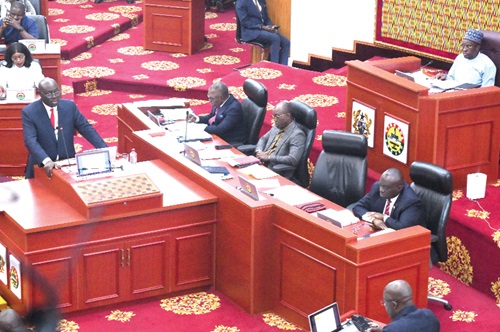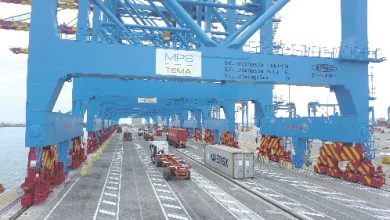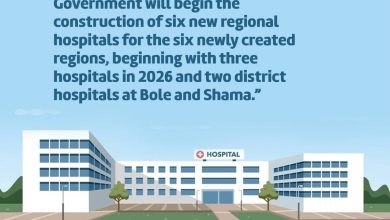
After successfully stabilising an economy that was in distress — burdened by debt, weakened by mismanagement and stripped of confidence — the government yesterday laid a blueprint of bold policies and programmes to build upon the gains achieved in the past 11 months to create more than 800,000 new jobs for Ghanaians.
On the theme: “Resetting for growth, jobs and economic transformation”, the 2026 budget is the current government’s second revenue and expenditure estimation instrument that seeks to chart a new path towards consolidation of macroeconomic stability, accelerate economic transformation, and strengthen the security and social sectors for economic growth.
The plan aims to sustain fiscal discipline, ensure responsible debt management, invest boldly in infrastructure, and expand transformative programmes such as the 24-Hour Economy Policy and the Big Push initiative.
The vision is to build a country that produces more than it consumes; exports value-added goods rather than raw materials; creates decent jobs with rising incomes; ensures opportunity is shared by all, and enables every citizen to live with dignity and pride.
In the two-hour-long presentation characterised by the usual cheers and jeers, the Minister of Finance, Dr Cassiel Ato Forson, said the government had planned to boost domestic revenue generation and rein in public spending to grow the economy.
“In 2026, the government expects to collect total revenue and grants of GH¢268.1 billion, up from GH¢226.7 billion in 2025, a strong 18.3 per cent increase, while the total expenditure on commitment basis for 2026 is projected at GH¢302.5 billion, equivalent to 18.9 per cent of gross domestic product (GDP), up from GH¢251.7 billion in 2025,” the minister said when delivering the 89-page Budget Statement.
Medium-term objective
He said the government’s mission for the coming year is to transform the hard-won stability of 2025 into shared prosperity.
“The sacrifices made by Ghanaians over the past year have restored hope and confidence in our economy by ensuring that inflation is down, the cedi is stronger, and growth has regained momentum.
“Our key fiscal policy priorities for 2026 are to maintain fiscal discipline by sustaining a primary surplus of at least 1.5 per cent of GDP on a commitment basis; mobilise more domestic revenue through continuous implementation of the medium-term revenue strategy,” he said.
He said it was also meant to promote value for money and rationalise spending, ensuring that every cedi delivers value for citizens while eliminating leakages and inefficiency; and protect priority social spending in education, health and social protection to shield the poor and sustain human capital development.
He added that the initiative was also intended to promote value for money and rationalise expenditure, ensuring that every cedi delivers maximum benefit to citizens while eliminating leakages and inefficiencies.
It further seeks to protect priority social spending in education, health, and social protection to support the poor and sustain human capital development.
Macroeconomic targets
The minister stated that the government has set bold but achievable macroeconomic targets for the 2026 fiscal year and the medium-term to advance the country’s medium-term macroeconomic goal of stability, resilience and shared prosperity.
“Mr Speaker, over the medium term, from 2026 to 2028, our real GDP is set to rise steadily, averaging about 4.9 per cent; non-oil GDP is programmed to grow around five per cent; inflation will stay within the 8±2 per cent target band, reflecting a firm grip on price stability; the fiscal balance will remain strong, with a primary surplus of 1.5 per cent of GDP from 2026 onward; and gross international reserves are expected to provide at least three months of import cover to anchor external resilience,” Dr Forson said.
He said in the 2026 fiscal year, the government would aim to achieve overall real GDP growth of at least 4.8 per cent, driven by continued expansion in infrastructure, services and agriculture.
The Finance Minister stated that the plan was to maintain end-year inflation of 8.0 per cent to consolidate the progress made in bringing prices under control and ease the cost of living for households.
Restored stability
Dr Forson stated that the choices the government made in 2025 had restored macroeconomic stability, rebuilt trust in the country’s fiscal institutions, and rekindled the hope of the people.
He explained that the task before the government now was to turn that stability into sustained progress and to make growth felt in every home, community, and enterprise.
“Mr Speaker, the 2026 Budget represents the next phase of our national renewal, a practical, forward-looking plan to consolidate gains, accelerate transformation, and secure prosperity for all Ghanaians.
“It is the next chapter in building the Ghana we want, a nation that works round the clock, creates opportunities for all, and protects the dignity and dreams of every citizen,” he said.
The minister stated that energy was the engine of the country’s transformation, with the goal of turning power from a constraint into a competitive advantage that fuelled the 24-Hour Economy, powered industry and created jobs.
He explained that the Gas-to-Power Strategy had been central to this vision as the shift from costly light crude oil to cleaner, locally produced natural gas reduced generation costs by up to 75 per cent, strengthened energy security and supported climate goals.
He said Ghana’s oil production, which declined from 71.4 million barrels in 2019 to an estimated 36 million barrels in 2025, was set for a rebound as President John Dramani Mahama’s decisive actions and investor-friendly reforms had already attracted over $3.5 billion in new investment commitments.
“The government’s investor-friendly reforms have already secured over $3.5 billion in new investment commitments.
These include a $2 billion framework agreement for the Jubilee and TEN fields to drill 20 new wells, and a $1.5 billion Memorandum of Intent with OCTP partners to expand operations,” he said.
He said in 2026, the government would roll out the Rural Electricity Acceleration and Urban Intensification Initiative to achieve universal access to power.
Textiles and garments
Dr Forson said the government was positioning modern textiles and garments as a cornerstone of Ghana’s industrial transformation.
He said three new garment factories, one in Bono East, another in Central, and the last in Eastern, would be established to operate under the 24-Hour Economy programme.
He said this would create about 20,000 direct jobs and boost community livelihoods through private sector partnerships.
End double track
The minister stated that the government was rolling out a two-year programme to end the double-track system in secondary schools.
“We will expand infrastructure, enhance quality, and improve access.
This programme will eliminate the double-track system and ensure that every child can attend school full-time, in dignity and in safety,” he said.
Dr Forson stated that the 2026 Budget would translate renewed confidence into tangible investments to improve daily lives — including the provision of better roads, schools, and hospitals, a reliable power supply, job opportunities, and targeted support for the vulnerable.
“Mr Speaker, to unlock round-the-clock productivity, exports, and decent jobs under the 24-Hour Economy, we are providing an allocation of GH¢110 million in 2026 for the implementation of the 24-Hour Economy programme.
“We have allocated an amount of GH¢2.2 billion to the Ministry of Food and Agriculture. GH¢245 million has been allocated for the Nkoko Nketenkete, livestock and other programmes in 2026,” he said.
Jobs
The minister maintained that the 2026 Budget Statement and Economic Policy were deliberately crafted to create up to 800,000 new jobs across various sectors.
The new jobs will be created from road contracts under the Big Push, three new factories, seven agro-processing plants, and a National Policy on Integrated Oil Palm Development.
He explained that the GH¢63 billion worth of road contracts awarded under the Big Push initiative alone would generate an estimated 490,000 jobs, in line with World Bank metrics on employment from infrastructure investments.
Additionally, he said, three new garment factories were expected to provide over 20,000 direct jobs, while seven agro-processing plants would employ about 700 people directly and thousands more through their supply chains.



